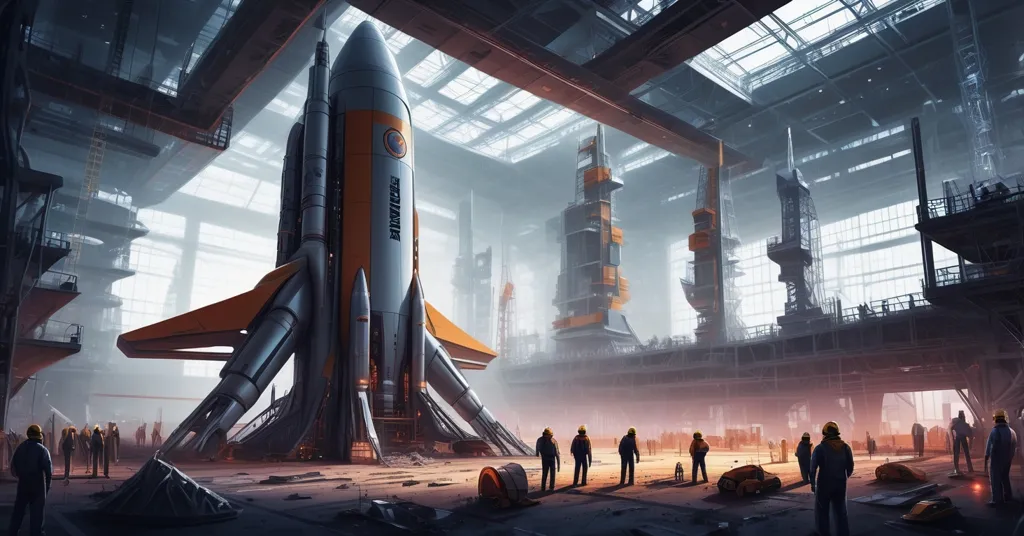SpaceX Safety Crisis:Lessons for Crypto’s Risky Disruption Push

SpaceX Safety Crisis: A Stark Warning for Crypto’s Disruptive Ambitions
Elon Musk’s SpaceX is rocketing toward Mars with dreams of colonization, but a growing worker safety crisis on Earth is threatening to ground those ambitions. Lawsuits from former employees alleging unsafe conditions and retaliatory firings, paired with injury rates far above industry norms, paint a damning picture of a company prioritizing speed over human well-being. For us in the crypto space, this saga hits close to home—disruption without guardrails can burn out workers or investors alike, whether you’re building rockets or blockchains.
- Worker Lawsuits: Former SpaceX staff claim wrongful termination for flagging dangerous practices and brutal schedules.
- Injury Stats: OSHA data reveals SpaceX injury rates nearly triple the aerospace average, signaling systemic issues.
- Crypto Parallel: SpaceX’s rush mirrors crypto’s own pitfalls of innovation over safety, with lessons for Bitcoiners and altcoin fans.
Allegations of Neglect: Lawsuits Expose a Troubling Culture
SpaceX, under Elon Musk’s relentless drive, has become a titan of aerospace innovation, logging 87 Falcon 9 launches in 2024 alone and developing the massive Starship rocket for NASA’s lunar missions and Starlink satellite networks. But behind the headlines of interplanetary progress, a darker story is unfolding. Two former employees, Robert Markert and David Lavalle, have filed lawsuits accusing the company of wrongful termination after they raised alarms about unsafe working conditions. Initially filed in Los Angeles County Superior Court, these cases escalated to the U.S. District Court for the Central District of California by July 2025, signaling a high-stakes legal battle that could tarnish SpaceX’s image. Details of these court filings highlight the severity of the allegations.
Robert Markert, a supervisor with 13 years at SpaceX until his dismissal in April 2025, didn’t mince words in his claims. He highlighted a particularly risky process involving rocket fairing retrieval—recovering the protective nose cone of a rocket after launch, a heavy and unwieldy component that, if mishandled, could crush workers or trigger deadly accidents. His warnings were allegedly dismissed by management as too expensive to fix.
“It was the more economical solution.”
That cold response, as cited in Markert’s lawsuit, speaks volumes about a culture where cost-cutting trumps safety. He also flagged grueling schedules, with technicians often working 15-20 consecutive days under crushing stress, leading to fatigue-driven mistakes and unreported injuries due to fear of retaliation. When he pushed for proper training and certifications to reduce these risks, the answer was even more infuriating.
“There is no time for that and the company would not spend money on it.”
Supervisors reportedly hammered home the mantra, “the schedule comes first,” a mindset that seems to permeate SpaceX’s operations, sacrificing worker health for Musk’s breakneck timelines. You can explore more about the broader context of these issues on SpaceX’s safety challenges.
David Lavalle, a 60-year-old plumber at SpaceX since 2014, adds another layer of grim detail. His lawsuit claims the company ignored multiple work-related injuries—a fractured foot, chronic neck pain, wrist issues—before firing him after he took medical leave for knee pain. He alleges age discrimination crept in after a 28-year-old senior manager, Scott Hiler, joined in late 2024, with older workers suddenly targeted for termination. These personal accounts aren’t just anecdotes; they’re backed by hard numbers. According to OSHA (Occupational Safety and Health Administration, the U.S. agency monitoring workplace safety) records analyzed by TechCrunch, SpaceX’s Starbase facility in Texas reported 4.27 injuries per 100 workers in 2024. To put that in perspective, for every 100 employees, over 4 are getting hurt—nearly triple the aerospace industry average of 1.6. Even worse, west coast fairing recovery operations clocked a staggering 7.6 injuries per 100 workers. These aren’t just stats; they’re a glaring sign of systemic failure. OSHA’s injury rate comparisons for Starbase paint a stark contrast to industry norms.
Starship Setbacks: Technical Woes Compound the Crisis
While workers battle for justice, SpaceX’s flagship Starship program—key to NASA lunar landings and Musk’s Mars vision—is hitting turbulence of its own. In May 2025, a test flight went haywire, breaking apart over the Indian Ocean after flying halfway around the world. The Federal Aviation Administration (FAA), the body overseeing U.S. aviation and spaceflight safety, ordered a formal accident probe into the incident, though no public injuries or property damage were reported. Still, it’s another crack in SpaceX’s armor at a time when Musk is pushing harder than ever to accelerate testing under his philosophy of effective accelerationism (e/acc)—a belief in driving tech progress at all costs. But when rockets and workers are breaking down in tandem, you’ve got to wonder: is this pace sustainable, or just a reckless gamble? For more on the ongoing crisis, check out insights into Musk’s safety challenges at SpaceX.
A Pattern of Risk: Musk’s Empire Under Scrutiny
Zooming out, this isn’t an isolated mess for SpaceX. Across Musk’s sprawling empire—six companies including Tesla and SpaceX—over 32 federal investigations or enforcement actions are underway as of early 2025, per recent reports from outlets like The New York Times. Past labor disputes at Tesla, with similar accusations of unsafe conditions and overwork, suggest a troubling pattern where innovation is king, and employee welfare is an afterthought. Musk’s history of retaliation claims across his companies adds weight to these concerns. Recent political shifts under the Trump administration in 2025 have replaced some Biden-era regulators with more Musk-friendly faces, potentially softening oversight. But even if legal heat eases, the human cost laid bare by these lawsuits can’t be waved away with a policy change. It’s a brutal reminder that disruption, whether in space or on the blockchain, often comes with collateral damage if unchecked.
Parallels to Crypto’s Innovation Trap
For those of us rooting for Bitcoin and decentralized tech, SpaceX’s saga feels eerily familiar. Just as Musk’s “move fast and break things” ethos drives Starship tests at the expense of safety, the crypto space is littered with projects that prioritize hype and speed over security. Think of the Terra/Luna collapse in 2022, where a rushed algorithmic stablecoin imploded, wiping out billions in investor funds due to untested mechanics. Or FTX, where negligence and unchecked ambition led to a spectacular downfall, leaving users high and dry. In both aerospace and crypto, the rush to disrupt—whether it’s colonizing Mars or reinventing finance—can screw over the little guy if accountability isn’t baked in. As Bitcoin maximalists, we cheer the challenge to centralized systems, but SpaceX’s alleged negligence is a gut check: true disruption can’t just be about speed. It’s got to protect the people fueling the revolution, be they workers or hodlers. Crypto’s parallels with SpaceX’s risky innovation offer a sobering perspective for investors.
Could Blockchain Offer a Fix for Corporate Opacity?
Here’s a thought to chew on: what if decentralized tech, the kind we champion, could help tackle issues like SpaceX’s workplace transparency failures? Imagine a blockchain-based system logging safety incidents or employee grievances on an immutable ledger, visible to all stakeholders without fear of retaliation or cover-ups. Ethereum smart contracts, for instance, could automate reporting protocols, triggering alerts or even compensation if certain safety thresholds are breached. Hell, a DAO (Decentralized Autonomous Organization, a community-run entity on the blockchain) structure could even give workers a direct voice in safety policies, cutting through corporate bureaucracy.
Now, let’s not get too starry-eyed. Centralized giants like SpaceX aren’t exactly lining up to adopt such tools—control is their game, and transparency often isn’t. Plus, data privacy concerns and implementation costs would be massive hurdles. Still, it’s worth pondering. Bitcoin taught us to challenge financial gatekeepers; why not repurpose that ethos to hold tech titans accountable on the factory floor? If nothing else, it’s a reminder of why decentralization matters—not just for money, but for power dynamics everywhere. Community discussions on platforms like Reddit about SpaceX lawsuits show growing public concern over these issues.
Counterpoint: The Cost of Pioneering Tech
To play devil’s advocate, let’s consider SpaceX’s side. High-risk industries like aerospace inherently face safety challenges—building rockets isn’t exactly a desk job. Musk and company might argue that pioneering tech demands a certain tolerance for risk, and they’ve likely made public statements about investing in safety measures (though specifics are scarce in these lawsuits). Their defenders could point to the sheer scale of their achievements—Starlink connecting remote regions, NASA partnerships propelling humanity to the moon—as justification for pushing hard. But here’s the rub: even if risk is inevitable, ignoring worker warnings and fostering a culture of fear isn’t innovation; it’s just shitty management. From a Bitcoin-maximalist lens, true disruption empowers individuals, not exploits them. SpaceX’s alleged approach feels more like centralized overreach than the freedom we fight for in crypto. For further reading on Musk’s broader impact, see coverage of SpaceX’s safety crisis.
Key Takeaways and Questions
- What’s driving the SpaceX worker safety crisis?
Lawsuits from ex-employees Robert Markert and David Lavalle allege unsafe conditions, ignored injuries, and brutal schedules (15-20 straight workdays), with firings for speaking out revealing a culture of speed over safety. - How severe are SpaceX’s injury rates compared to industry standards?
OSHA data shows SpaceX’s Starbase at 4.27 injuries per 100 workers in 2024, nearly triple the aerospace norm of 1.6, with some operations hitting 7.6 per 100—a troubling sign of widespread risk. - Could this impact Musk’s Mars and NASA lunar ambitions?
Not directly, but legal battles, reputational hits, and potential regulatory crackdowns from OSHA or the FAA could slow timelines and force costly policy shifts. - What can crypto enthusiasts learn from SpaceX’s missteps?
Much like SpaceX’s rush risks worker harm, crypto projects often sacrifice security for speed—think Terra/Luna or FTX—reminding us that disruption without responsibility can backfire on users or adopters. - Can blockchain tech address corporate safety transparency?
Theoretically, immutable ledgers could log incidents transparently, and smart contracts could automate accountability, though corporate resistance and practical barriers make adoption a long shot.
SpaceX’s worker safety crisis isn’t just a legal spat—it’s a cautionary tale for any field chasing disruption, crypto included. Musk’s push for Mars mirrors Bitcoin’s fight against financial tyranny, but without guardrails, ambition can turn toxic. As we hodl our BTC or explore altcoin niches, let’s ask ourselves: can true innovation thrive if it’s built on broken backs, whether in a rocket factory or a rug-pulled DeFi project? For now, SpaceX’s road to the stars looks as rocky as a bear market—and the human cost might be the hardest launch failure to fix.



